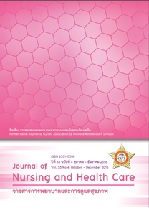การประยุกต์ใช้รูปแบบการดูแลแนะนำในการสนับสนุนการจัดการ ด้วยตนเอง สำหรับผู้สูงอายุที่มีโรคเรื้อรังหลายโรค ในชุมชนแห่งหนึ่ง จังหวัดขอนแก่น Application of the Guided Care Model to Support Self Management of older Persons with Multimorbidity in a Community of
บทคัดย่อ
การวิจัยเชิงปฏิบัติการครั้งนี้ เป็นการประยุกต์ใช้องค์ประกอบของรูปแบบการดูแลแนะนำ ในการสนับสนุน
การจัดการด้วยตนเองสำหรับผู้สูงอายุที่มีโรคเรื้อรังหลายโรคในชุมชนแห่งหนึ่ง จังหวัดขอนแก่น ผู้ที่มีส่วนร่วมใน
การวิจัยเชิงปฏิบัติการ ได้แก่ บุคลากรทีมสุขภาพของหน่วยบริการปฐมภูมิที่ศึกษา ประกอบด้วย แพทย์ 1 คน
พยาบาลวิชาชีพ 3 คน ผู้ช่วยพยาบาล 2 คน เจ้าหน้าที่ธุรการ 1 คน และบุคลากรทีมสหสาขาวิชา ประกอบด้วย
แพทย์ผู้เชี่ยวชาญด้านผู้สูงอายุ 1 คน พยาบาล 2 คน เภสัชกร 1 คน นักกายภาพบำบัด 1 คน โภชนากร 1 คน
นักสังคมสงเคราะห์ 1 คน และผู้ให้ข้อมูลหลัก จำนวน 38 คน ได้แก่ ผู้สูงอายุ ผู้ดูแล อสม. ผู้นำชุมชน กรรมการ
ชุมชน เก็บรวบรวมข้อมูลเชิงคุณภาพ ด้วยวิธีการสนทนากลุ่ม การสัมภาษณ์เชิงลึก การสัมภาษณ์อย่างไม่เป็น
ทางการ การสังเกต การศึกษาเอกสาร และการบันทึกภาคสนาม วิเคราะห์ข้อมูลเชิงคุณภาพด้วยการวิเคราะห์
เนื้อหาและวิเคราะห์ข้อมูลเชิงปริมาณโดยใช้สถิติเชิงพรรณนาระยะเวลาดำเนินการศึกษาตั้งแต่ พฤศจิกายน พ.ศ.
2556 - มกราคม พ.ศ. 2558 ผลการศึกษา มีดังนี้ 1) ผู้สูงอายุที่มีโรคเรื้อรังหลายโรคในชุมชนที่ศึกษาซึ่งเป็นชุมชนกึ่งเมือง มีความแตกตา่ งตามลักษณะการจัดกลุม่ ผูสู้งอายุ 3 กลุม่ ดังนี้ กลุม่ ที่ 1 ผูสู้งอายุดูแลตนเองและชว่ ยเหลือผูอื้่นได ้ มีบทบาทในชุมชน ทั้งการเป็นผู้นำ ผู้ร่วมกิจกรรมและเป็นทรัพยากรทางความรู้ อนุรักษ์ภูมิปัญญาท้องถิ่น กลุ่มนี้มีความต้องการคำแนะนำในการปรับพฤติกรรมที่เหมาะสมในภาวะที่มีความซับซ้อนจากโรคเรื้อรังหลายโรค กลุ่มที่ 2
ผู้สูงอายุที่ดูแลตนเองได้เท่านั้นไม่สามารถออกนอกบ้านได้ ต้องการการช่วยเหลือดูแลเพื่อส่งเสริมการทำหน้าที่ใน
กิจวัตรประจำวันและการควบคุมโรคเรื้อรังหลายโรคที่ซับซ้อน กลุ่มที่ 3 ผู้สูงอายุที่ช่วยเหลือตนเองไม่ได้
ต้องการการพึ่งพาทั้งหมด เนื่องจากปัญหาสุขภาพและข้อจำกัดของความสามารถในการทำหน้าที่ ซึ่งมักมีผลต่อ
ภาวะจิตใจร่วมด้วย 2) การประยุกต์ใช้องค์ประกอบของรูปแบบการดูแลแนะนำในการสนับสนุนการจัดการด้วย
ตนเอง สำหรับผู้สูงอายุที่มีโรคเรื้อรังหลายโรคในชุมชนแห่งนี้ ประกอบด้วย 4 ขั้นตอน ขั้นตอนที่ 1 นำเสนอแนวคิด
รูปแบบการจัดการดูแลผูป้ ว่ ยเรื้อรังและรูปแบบการดูแลแนะนำ เพื่อกำหนดแนวทางการดำเนินงานรว่ มกับบุคลากร
หน่วยบริการปฐมภูมิที่ศึกษาและทีมสหสาขาวิชาชีพ ขั้นตอนที่ 2 ระดมสมองเพื่อกำหนดเป้าหมายและวางแผน
การประยุกต์ใช้รูปแบบการดูแลแนะนำในการสนับสนุนการจัดการด้วยตนเอง สำหรับผู้สูงอายุที่มีโรคเรื้อรังหลาย
โรค ขั้นตอนที่ 3 การดำเนินการให้บริการโดยใช้รูปแบบการดูแลแนะนำเพื่อการสนับสนุนการจัดการด้วยตนเอง
ขั้นตอนที่ 4 สรุปและประเมินผลการดำเนินการให้บริการโดยใช้รูปแบบการดูแลแนะนำ 3) ผลลัพธ์จากการประยุกต์
ใช้รูปแบบการดูแลแนะนำในการสนับสนุนการจัดการด้วยตนเอง สำหรับผู้สูงอายุที่มีโรคเรื้อรังหลายโรค คือ
3.1) ได้รูปแบบการดูแลแนะนำในการสนับสนุนการจัดการด้วยตนเอง สำหรับผู้สูงอายุที่มีโรคเรื้อรังหลายโรคซึ่ง
เหมาะสมกับบริบทที่ศึกษา 3. 2) การพัฒนาบทบาทพยาบาลผู้ดูแลแนะนำและขั้นตอนการดำเนินงานตามรูปแบบ
การดูแลแนะนำในการสนับสนุนการจัดการด้วยตนเอง สำหรับผู้สูงอายุที่มีโรคเรื้อรังหลายโรคในชุมชน
This action research was aimed at applying the Guided Care Model to support self – management of older persons with multimorbidity in a community at Khon Kaen province. The participants involved in the research included health care personnel of the primary care unit: one doctor, three register nurses,two nursing assistant, one administrative person; and multidisciplinary team : one geriatrician, two nurses,one pharmacist, one physiotherapist, one nutritionist, one social worker ; and thirty-eight key informants including older persons , their care givers, health care volunteers, community leaders and village committee.
Qualitative data were obtained by using focus group discussions, in – depth interviews, informal interview,observations, document review, and field note. Content analysis was used to analyze qualitative data and quantitative data were analyzed by descriptive statistics. The study was conducted during November 2013 to January 2015.
The results were as follows: 1) Older persons with multimorbility in this semi-urban community are different in three groups: 1) Older persons who could take care of themselves and could help other people, still actively participated or even lead community activities, and were considered a good resource for indigenous knowledge. This group required a proper advice on how to adjust their behaviors in order to manage with their health related to complex problems from multimorbility. 2) Older persons who could still
take care of themselves, but not being able to carry out any outdoor activities. Their need for support in daily life activities and control health complexity from multimorbility. 3) Older persons who could not take care of themselves and totally dependent. They need support due to complex health problems, and limitation in functional ability which was mostly related to psychological problems. 2) The application of the Guided Care Model elements to support self-management for older persons with multimorbidity in this ommunity consisted of four steps: Step 1 was to introduce the concept of the Chronic Care Models and the Guided Care Model in order to establish a direction together with the primary care personnel and multidisciplinary team, Step 2 was to brainstorm in order to create a mutual goal and plan to apply the Guided Care Model, Step 3 was to implement the Guided Care Model to support self-management for older persons with multimorbidity, and Step 4 was to summarize and evaluate the health care service of applying the
Guided Care Model. 3) Benefits from applying the Guided Care Model to support self-management for older persons with multimorbidity: 3.1) the development of health care service to support self-management for older persons with multimorbidity in the context of this study. 3.2) the development in roles of guided care nurse and guideline of care for older persons with multi-morbidity in the community.



